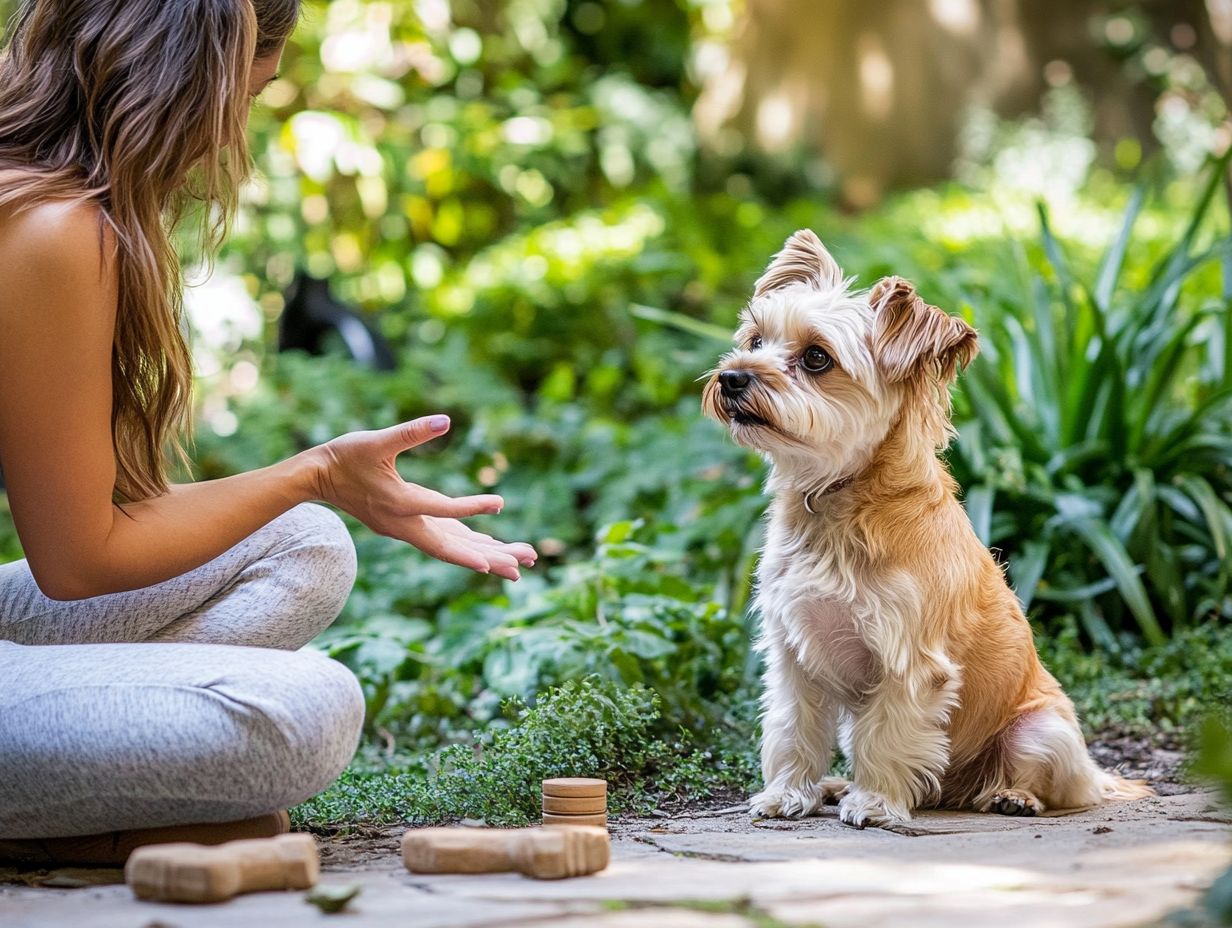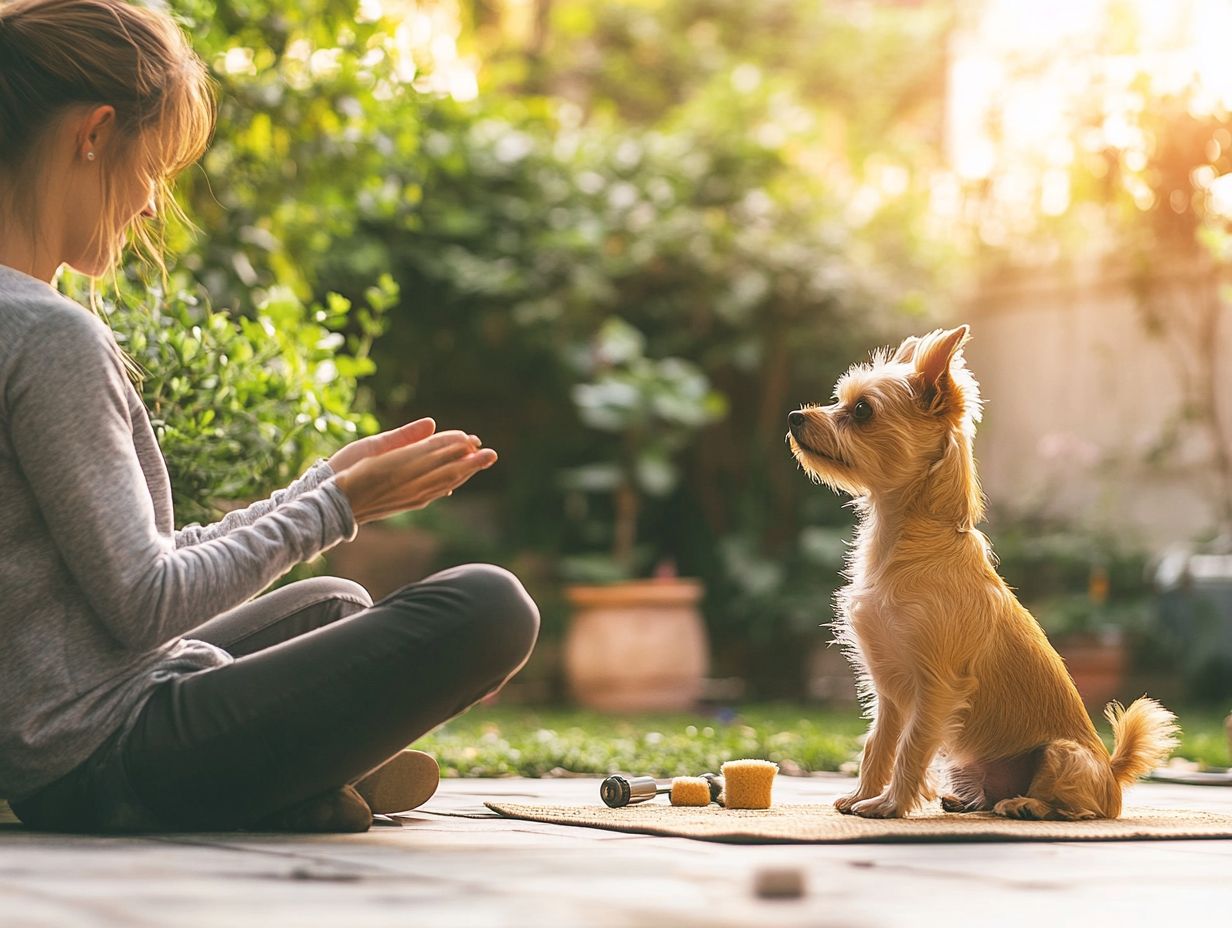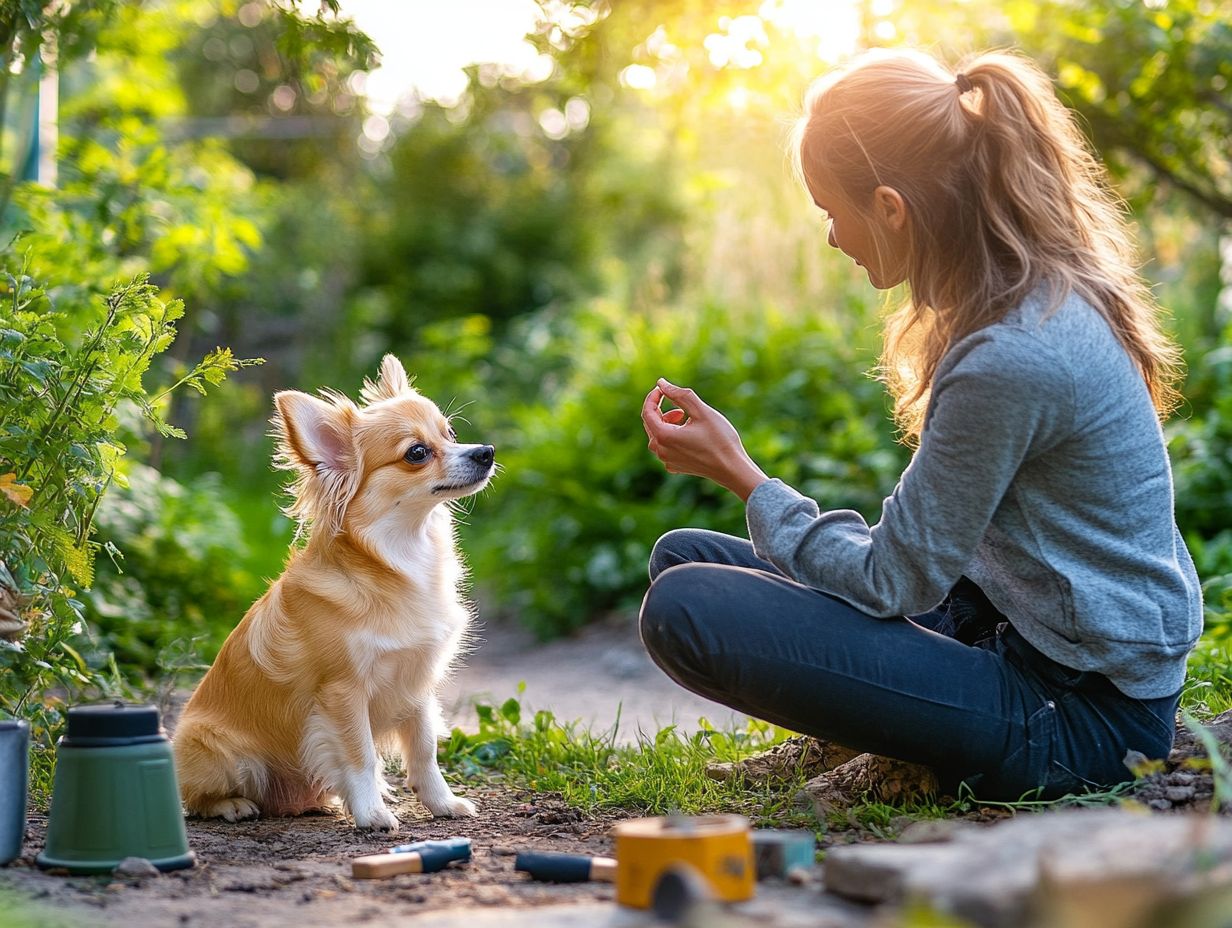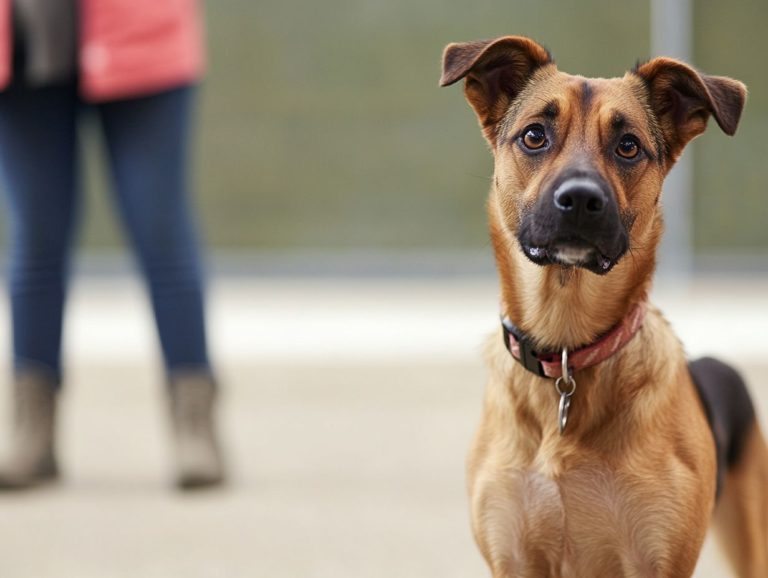5 Essential Commands for Anxious Dogs
Training an anxious dog through effective dog training techniques can be a rewarding yet challenging journey for you.
By mastering the five essential commands Sit, Stay, Come, Leave It, and Down you can significantly enhance your dog’s behavior and emotional well-being. These commands provide structure and foster a sense of security for your pup, creating a more harmonious environment.
This article delves into how these essential commands can help manage anxiety, providing training tips for effective training along the way. You’ll also find success stories that showcase their transformative impact.
Ultimately, mastering these commands can deepen the bond between you and your furry friend, ensuring they respond to your cues and remain calm even in the most stressful situations.
Contents
- Key Takeaways:
- 1. Sit
- 2. Stay
- 3. Come
- 4. Leave It
- 5. Down
- How Can These Commands Help Anxious Dogs?
- What Are the Benefits of Teaching These Commands to Anxious Dogs?
- How Can These Commands Be Used in Different Situations?
- What Are Some Tips for Effective Training of These Commands?
- What Are Some Common Mistakes to Avoid When Training Anxious Dogs?
- What Are Some Other Helpful Commands for Anxious Dogs?
- How Can These Commands Help Improve the Bond Between a Dog and Their Owner?
- What Are Some Ways to Keep Anxious Dogs Calm in Stressful Situations?
- How Can These Commands Be Used in Combination with Other Techniques for Anxious Dogs?
- What Are Some Success Stories of Using These Commands with Anxious Dogs?
- What Are Some Potential Challenges When Training Anxious Dogs with These Commands?
- Frequently Asked Questions
- What are the 5 basic commands for anxious dogs?
- Why are these commands important for anxious dogs?
- How can I teach my anxious dog these commands?
- What should I do if my anxious dog struggles with learning these commands?
- Can these commands also help with other dog behavior issues in anxious dogs?
- Are there any other techniques or tools that can help anxious dogs in addition to these commands?
Key Takeaways:

- Training essential commands like Sit, Stay, Come, Leave It, and Down can greatly benefit anxious dogs by providing them with structure, routine, and a sense of control in their environment, reinforcing positive dog behavior.
- You can use these commands at home, in public, or during stressful events to help keep anxious dogs calm and focused on you while practicing the recall command.
- Consistent training with rewards, patience, and understanding are crucial for effectively teaching these commands and strengthening the bond between you and your dog.
1. Sit
The Sit command is one of the essential building blocks of dog training that every dog owner should teach their dog. It serves as a foundation for good behavior and obedience in a variety of situations, from interactions with other dogs to encounters with strangers.
By mastering this straightforward yet powerful command, your dog can develop self-control, making it much easier for you to manage them in challenging environments.
To teach Sit, you can lure your dog with treats, gently guide them, or use a clicker to mark the desired behavior. Rewarding your dog with treats or praise encourages them to repeat good behaviors, creating a strong bond between you and your pet.
If you prefer professional assistance, Montecito Pet Concierge offers customized training programs that can help you implement these techniques effectively, ensuring you have a well-mannered companion who responds reliably to commands.
2. Stay
The Stay command is essential in dog training, granting you the ability to manage your pet’s movements and ensure their safety in various settings. It reinforces desirable behaviors and creates a calm atmosphere during your outings.
This command not only gives you control but also acts as a safeguard against accidents in busy streets or crowded parks. To train your dog effectively, use positive methods, such as treats or praise, whenever your dog successfully holds their position.
Start with short durations and gradually increase the time, allowing your dog to grasp the command intuitively. There are specific scenarios where the Stay command proves invaluable, including:
- Waiting at crosswalks
- Preventing unsolicited jumping on visitors
- Maintaining calm during mealtime
By mastering this command, you ensure that both your pet and the environment remain serene and safe.
Start today to see the amazing difference it can make in your dog’s life!
Don t wait transform your dog’s life and your relationship today!
3. Come
The ‘Come’ or recall command is an essential tool in your dog training repertoire. It allows you to ensure your dog s safety by calling them back in potentially dangerous or distracting situations. It also strengthens the bond between you and your furry friend.
This command acts as a critical lifeline, especially in environments fraught with risks, such as near busy roads or unfamiliar places. To teach this command effectively, you need consistency, practice, and a keen understanding of how dogs behave.
Employing techniques like positive reinforcement not only encourages your dog to comply but also builds a trusting relationship between the two of you.
When your dog responds to the recall command, rewarding them with treats, praise, or playtime transforms the experience into something enjoyable for them. Montecito Pet Concierge offers specialized training sessions that focus on these techniques. Start practicing these commands today to strengthen your bond!
4. Leave It
‘Leave It’ stands as a crucial command in dog training, giving you the power to prevent your dog from picking up harmful objects or getting distracted. This enhances safety and promotes good behavior in various situations.
Mastering this command is essential for protecting your furry friend from potential hazards like toxic substances or sharp objects that may be present during walks. It also plays a vital role in managing their impulses.
Picture this: during outdoor adventures, your dog might spot something irresistible, like discarded food or another animal, which could trigger unwanted behaviors. To achieve better results, consider training tips like using treats to reinforce this command or starting in low-distraction environments.
Using the ‘Leave It’ command helps to minimize the risk of accidents and ensures a more enjoyable outing for both you and your dog. Imagine the peace of mind it brings!
5. Down
Teaching your dog the ‘Down’ command enhances dog obedience and helps calm those energetic pups. This allows you to manage their behavior in a variety of situations.
When you instruct your dog to assume a relaxed position, you’re encouraging them to focus and channel their energy in a more constructive way. This technique becomes particularly beneficial during stressful moments, like visits to the vet or encounters with unfamiliar dogs.
Positive reinforcement works wonders in this training. Using dog treats and praise to reward desirable behaviors reinforces this training. If you find yourself facing challenges, Montecito Pet Concierge is there to offer guidance. They tailor your training sessions to your dog’s unique needs, ensuring a calm and structured training environment.
Start strengthening that bond today through effective training techniques!
How Can These Commands Help Anxious Dogs?

Teaching essential commands like Sit, Stay, Come, Leave It, and Down can profoundly benefit anxious dogs. These commands offer the structure and predictability they crave, which is vital for navigating stressful situations and building their confidence. For more insights, check out understanding basic commands for anxious pets.
As your anxious dog masters these commands, they’ll learn to channel their energy positively, leading to calmer behavior even in moments that might typically trigger their anxiety. For example, ‘Sit’ is a straightforward yet effective command that encourages them to settle down, while ‘Stay’ can help prevent them from bolting in overwhelming environments. Implementing techniques for building confidence in anxious dogs can further enhance their training and overall well-being.
Positive reinforcement is key in this training journey. By rewarding them with dog treats or praise for successfully following commands, you re not just reinforcing good behavior; you’re also fostering a trusting bond between you and your dog.
Montecito Pet Concierge gets that every dog is unique and needs personalized training. This ensures they receive the support necessary to thrive and find comfort in their surroundings. Start this rewarding journey today!
What Are the Benefits of Teaching These Commands to Anxious Dogs?
Teaching essential commands to anxious dogs presents a wealth of benefits, including improved dog behavior. You’ll notice improved self-control, enhanced communication between you and your dog, and a comforting sense of security that can ease anxiety in stressful situations. Utilizing essential training tools for anxious pets can further enhance this process.
By instilling commands like “sit” or “stay”, you create a structured environment that reduces your dog s uncertainty during potentially overwhelming moments, such as when guests arrive or loud noises disrupt the peace. For example, a dog trained to settle on a mat when visitors come over experiences significantly less stress, reassured by your ability to manage their behavior effectively.
As your dog masters these commands, the bond between you deepens, building trust and making commands clear. This collaborative effort reinforces the idea that you are a source of safety, which can greatly diminish anxiety levels. When you observe the benefits firsthand, you ll often witness impressive behavioral transformations and a calmer demeanor in your furry companion.
How Can These Commands Be Used in Different Situations?
Essential commands such as Sit, Stay, Come, Leave It, and Down can significantly enhance your control over your dog in various situations, aiding in effective dog training. Whether you re managing a vet visit, overseeing interactions with other pets, or ensuring safety in public spaces, these commands are invaluable.
For instance, when navigating through busy parks or crowded events, the ‘Stay’ command provides crucial control, preventing your dog from darting into unpredictable situations. Similarly, ‘Leave It’ proves invaluable when you encounter discarded food or suspicious items, keeping your pet safe from harmful substances.
In scenarios where a surprise greeting from another dog might occur, the ‘Come’ command fosters responsible interactions, ensuring both animals remain calm and friendly. Each essential command not only enhances your pet’s obedience but also promotes a secure and enjoyable environment for everyone involved.
What Are Some Tips for Effective Training of These Commands?
Effective training of basic commands requires your patience, consistency, and the savvy use of positive reinforcement techniques, which means rewarding desired behavior. Think of those dog treats as your secret weapon to encourage the behaviors you want.
By maintaining a structured routine and ensuring enjoyable training sessions, you create a positive atmosphere that fosters trust and cooperation. When introducing new commands, start in a distraction-free setting and gradually increase the level of difficulty.
Using high-value treats like small morsels of cooked chicken or cheese can significantly motivate your dog, especially if they re not excited about standard biscuits. By recognizing individual behaviors, you can tailor your approach to align with your dog s unique personality, making the learning process effective and genuinely enjoyable.
What Are Some Common Mistakes to Avoid When Training Anxious Dogs?
Dog owners often fall into traps when training anxious dogs, such as resorting to harsh corrections or overlooking their pet’s subtle stress signals. These missteps can impede progress and amplify anxiety, making it crucial to consider specific training tips for anxious dogs.
Such errors may breed increased mistrust or fear, complicating the training journey. To cultivate a successful learning environment, observe your dog s body language. Signs of stress can include panting, cowering, or a lack of focus. When these cues are overlooked, it can lead to frustration for both you and your dog.
By embracing positive reinforcement techniques and exercising patience, you can foster a nurturing atmosphere that promotes progress, helping your furry companion gradually build confidence in a safe and supportive setting. Start practicing these commands today for a happier, more confident pup!
In conclusion, training is essential for anxious dogs because it provides them with a sense of security and predictability. You’ll be amazed at how much your dog can improve when you invest time and care in their training.
What Are Some Other Helpful Commands for Anxious Dogs?
Along with the fundamental commands like Sit and Stay, other commands such as Heel and Leave It can greatly assist in managing the behavior of anxious dogs, enhancing their training and overall well-being.
By incorporating the Heel command, you can teach your furry companion to walk calmly beside you. This instills a sense of security during outings, strengthening your bond and helping to alleviate the stress that can come from unpredictable environments.
The Focus command encourages your dog to look at you, effectively redirecting their attention from anxiety-inducing stimuli. Regularly practicing these commands in short, positive training sessions can transform your dog s nervousness into confidence, leading to a more relaxed and well-adjusted pet.
How Can These Commands Help Improve the Bond Between a Dog and Their Owner?

Teaching essential commands to your dog does more than just improve obedience; it fosters a deeper bond between you and your furry friend. Effective communication and positive reinforcement create an atmosphere of trust and understanding that transforms your relationship.
This dynamic enhances your emotional connection in ways that transcend simple training. Each session becomes an opportunity for shared joy and achievement. For example, when your dog finally sits on command after some persistent practice, the tail-wagging excitement that follows reinforces your nurturing approach. Those moments filled with laughter and celebration turn training into a delightful experience.
As you navigate challenges together like mastering the Stay or Down commands you cultivate patience and empathy, enriching your relationship further. Over time, these positive interactions solidify a sense of partnership, making each command a meaningful step toward a more profound companionship.
What Are Some Ways to Keep Anxious Dogs Calm in Stressful Situations?
To keep your anxious dog calm in stressful situations, you can utilize essential commands, create a comforting environment, and employ positive reinforcement techniques that help your pet feel secure and relaxed.
Establishing a routine can be particularly beneficial; it offers predictability, which often soothes nervous dispositions. When introducing new commands, simple cues like ‘sit’ or ‘stay’ can effectively redirect their focus away from stressors. A gentle touch provides much-needed physical comfort.
Rewarding desired behaviors with treats or praise reinforces a sense of accomplishment and boosts their confidence. Designating a safe space within your home like a cozy bed or crate allows anxious dogs to retreat and decompress when feeling overwhelmed. This strategy is essential for managing your dog’s anxiety.
How Can These Commands Be Used in Combination with Other Techniques for Anxious Dogs?
Combining essential commands with techniques like clicker training or the recall command can significantly enhance your dog training efforts for anxious dogs, leading to more positive outcomes.
By integrating commands like ‘sit’ or ‘stay’ with clicker training, you create a rewarding cycle that encourages the behaviors you want to see. For example, when your dog sits calmly in a stressful situation and receives a click followed by a treat, they begin to associate the command with a rewarding outcome, helping to reduce anxiety over time.
You can also pair getting your dog used to things that scare them with commands. Gradually exposing your dog to triggering situations while practicing commands like ‘focus’ or ‘leave it’ can greatly reduce their fear response. This combination strengthens the bond between you and your dog while equipping them with effective coping strategies for handling anxiety-inducing scenarios.
What Are Some Success Stories of Using These Commands with Anxious Dogs?
Numerous success stories illuminate the transformative power of teaching essential commands to anxious dogs. This organized training, along with positive reinforcement, can make a big difference in their behavior and confidence.
Imagine the joy when your timid rescue pup becomes a playful social butterfly after learning simple commands! For instance, consider a dog owner who witnessed a remarkable transformation in her timid rescue pup, previously prone to cowering at the slightest sound. After consistent practice with commands like “sit” and “stay,” the dog not only began responding eagerly but also displayed a newfound self-assuredness, even engaging in playful interactions with other dogs at the park.
Another pet parent recounted how teaching the command “leave it” gave his anxious pooch the power to navigate stressful situations, making their daily walks far more enjoyable.
These anecdotes highlight the big difference that simple commands can have not just on obedience, but also on a dog’s overall demeanor. They underscore the deep bond forged through this nurturing process, showcasing the importance of dog owner engagement.
What Are Some Potential Challenges When Training Anxious Dogs with These Commands?
Training anxious dogs in essential commands can indeed pose several challenges. You may encounter difficulties with focus, fear responses, and resistance to learning, all of which call for your patience and a tailored approach.
Remember, every dog is unique; what resonates with one may not have the same effect on another, especially when they are learning the ‘stay’ command. For example, while some dogs might respond well to gentle encouragement, others could feel overwhelmed by such pressure.
It’s vital to create a comforting learning environment, as a secure and relaxed atmosphere will help your dog concentrate better. Gradually introducing new commands and breaking them into smaller, manageable steps can also ease their anxiety.
Incorporate positive reinforcement techniques like dog treats or praise to motivate your anxious dog to engage more fully during training sessions.
Frequently Asked Questions
What are the 5 basic commands for anxious dogs?

The 5 essential commands for anxious dogs are: “sit,” “stay,” “come,” “down,” and “leave it.” Learning these effective commands for calming anxious dogs can help manage and calm an anxious dog’s behavior.
Why are these commands important for anxious dogs?
These commands are important for anxious dogs because they provide structure and consistency, which can help reduce their anxiety, reinforcing the commands’ importance. Additionally, engaging in fun activities to help anxious dogs relax gives owners a way to redirect their dog’s attention and behavior in stressful situations.
How can I teach my anxious dog these commands?
The best way to teach anxious dogs these essential commands is through positive reinforcement training. This involves rewarding your dog with treats or praise when they successfully perform the command, while ignoring or redirecting undesirable behavior. For more insights, check out the top 5 training techniques to reduce pet anxiety.
What should I do if my anxious dog struggles with learning these commands?
If your anxious dog is having trouble learning these commands, it’s important to be patient and consistent in your training. You may also want to seek the help of a professional dog trainer who specializes in working with anxious dogs. Consider trying 5 tricks to help anxious pets feel secure. Don’t hesitate to reach out for help; your dog’s happiness depends on it!
Can these commands also help with other dog behavior issues in anxious dogs?
Yes, these commands can also help with other behavior issues in anxious dogs, such as excessive barking, jumping, or destructive behaviors. By providing structure and redirecting their attention, these commands can help anxious dogs learn to cope with their triggers and respond in a more calm and controlled manner. For more insights, check out 5 techniques for calming anxious pets.
Are there any other techniques or tools that can help anxious dogs in addition to these commands?
In addition to these commands, there are also other techniques and tools that can help anxious dogs, such as calming supplements, aromatherapy, and desensitization training. It’s important to consult with a veterinarian or professional dog trainer to determine the best approach for your dog’s specific needs.






